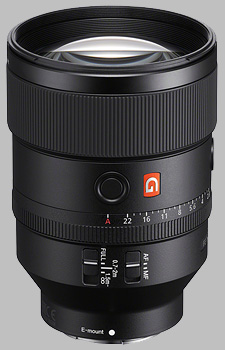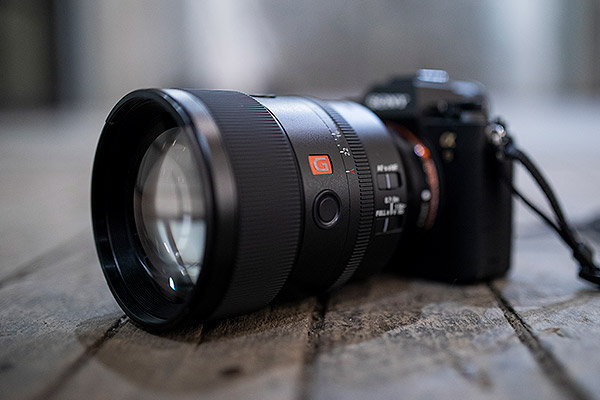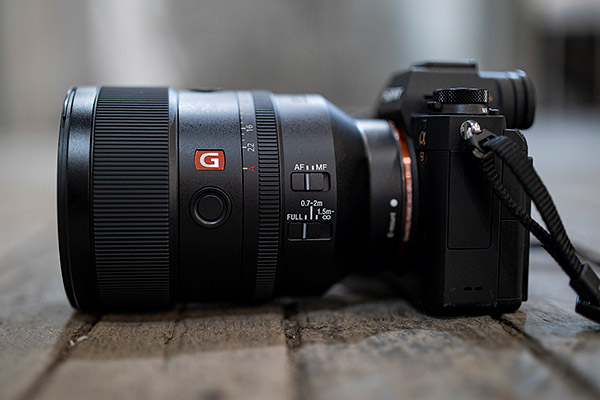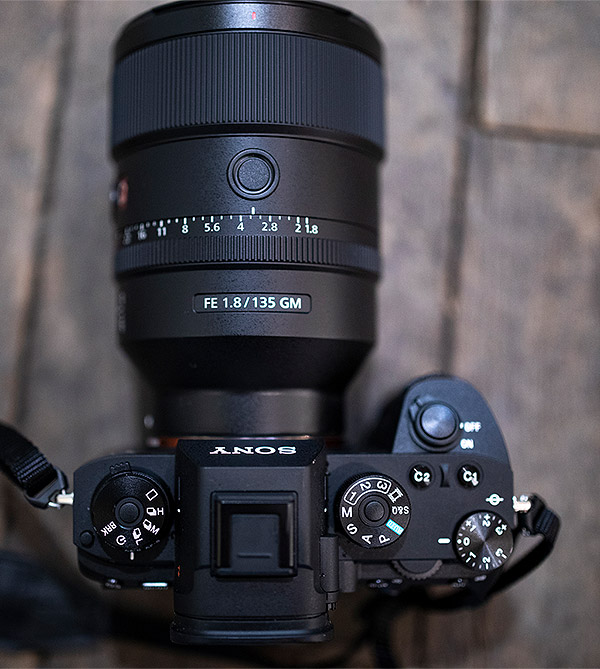| 135mm |
$2,098 average price |
|---|---|

|
|
Your purchases support this site
Buy the Sony FE 135mm f/1.8 GM SEL135F18GM
Sony FE 135mm f/1.8 GM Field Test
A modern blend of masterful design and high-end results
by Jaron Schneider | Posted: 02/26/2019
In late 2018, Sony just about wrapped up a more-or-less complete full-frame FE-mount lens lineup with the launch of the 24mm f/1.4 GM. Though there are of course more lenses they could add to their, at the time, 30 FE lens lineup, the bread-and-butter had been completed. They had range, and with that they could focus on excellence and specialty lenses. But more than just releasing lenses to say they have them available, Sony has seemingly upped the standard of their optics at the same time. Last year, that aforementioned 24mm f/1.4 ended up being one of the best prime lenses they, and arguably anyone, had ever released. Their 400mm G-Master is another example of greatness, though their production of that lens has been strained.
So when Sony announced another G-Master lens for their full-frame lineup, it's not because the lens was absolutely necessary to move cameras anymore. Now Sony can flex a little bit and really show what they can do.
Sony A9 + FE 135mm f/1.8 GM: f/1.8, 1/640s, ISO 320. Click for full-res image. Raw file converted with ACR in Photoshop CC 2019. |
The Sony 135mm f/1.8 G-Master absolutely feels like a flex. This is Sony showing off. This, the ninth G-master lens, is still somehow setting new standards for what a lens can and should be. Sony argues this lens will beat any available 135mm on the market and before I shot with it, I was dubious. Now? Now I feel like they are less bragging than stating an incontestable truth.
Lens Design
 |
The Sony 135mm f/1.8 GM is a portrait lens, and that should go without saying. The deep throw of 135mm limits perspective distortion and allows for faithfully represented faces. The difference between a photo taken at 50mm or even 85mm compared to 135mm is stark. If you have the space to use a 135mm for portraiture, especially headshot portraiture, the advantages are clear. In Sony's specific case here, they chose to build their 135mm to offer both high resolution as well as "extreme" performance with regards to focusing.
The lens is built of 13 elements in 10 groups, including XA (extreme aspherics) and Super ED elements to give that aforementioned high resolution. The 11-bladed circular aperture combined with high surface precision of the XA element, and careful control of spherical aberration all produce a smooth, elegant and circular bokeh.
 |
The 135mm G-Master uses two unique actuators called Extreme Dynamic (XD) Linear motors to allow for extremely fast and constant autofocus adjustment. Sony's original XD linear motor design offers extremely fast response time and low vibration that contribute directly to fast, precise, quiet autofocus operation. The XD linear motors make it possible to focus on moving subjects with speed, precision and reliability with minimal to nonexistent focus breathing. Additionally and specific for the 135mm, new control algorithms developed specifically for the XD linear motors produce quiet and low vibration AF operation.
The two focusing groups are part of an entirely floating focusing mechanism. That floating focus mechanism allows for improved close-up capability and prevents aberration variations that can occur as the focusing distance changes. This also allows for a pretty impressive close focusing distance of 2.3 feet (0.7m) with a max magnification of .25x.
 |
Finally, Sony gave the 135mm G-Master a de-clickable aperture ring. It was mentioned earlier that the lens has minimal focus breathing, and that combined with the de-clicked aperture ring makes this a formidable video lens in addition to its portrait still prowess.
Performance
So, enough about how and why the lens should be good at making images, let's talk about the "if it is" and the "how it does" part, which is arguably the most important.
So I ask: "does this lens take great images?" And more than that, "what makes this lens unique and worth coveting?"
Sony A7R III + FE 135mm f/1.8 GM: f/1.8, 1/250s, ISO 100. Click for full-res image. Raw file converted with ACR in Photoshop CC 2019. |
When I look back at the shooting event Sony put together for us, which was in a large open space in Brooklyn for just a couple hours, I can only think of one other shooting event from any camera company where I looked back over my images and thought "wow." And this is actually the first time that I can honestly say I said "wow" more than one time. In just two hours in a relatively contrived photo testing environment, I captured nine images that just blow me away.
That never happens.
I am a landscape photographer if you want to consider me a photographer at all, and more of a documentary filmmaker. So I'm honestly just terrible as a portrait photographer. I'll never claim it's a strong suit of mine, but something about putting the 135mm in my hands made me feel like a portrait photographer. Images I took just jumped off the back of the camera's LCD, and I was getting excited about what I was capturing.
From an "optical excellence" perspective, Sony promised that this lens would have corner to corner sharpness with minimized chromatic aberration. In looking at the images I shot, I can't say I disagree. All my "keeper" photos I shot wide open at f/1.8 because I'm kind of a sucker for wide aperture, and I'm pretty happy I did so. Not only does the bokeh look striking, but it lets us see that even subjects off center by a considerable margin are, at least to my eye, just as sharp as those directly in the center.
For example, let's take a look at this photo:
Sony A7R III + FE 135mm f/1.8 GM: f/1.8, 1/250s, ISO 100. Click for full-res image. Raw file converted with ACR in Photoshop CC 2019. |
In this image, the model is pretty much dead center of frame and looking directly at the lens. This is situation where you would expect the optic to be performing at its best. Here is another example of that:
Sony A7R III + FE 135mm f/1.8 GM: f/1.8, 1/125s, ISO 100. Click for full-res image. Raw file converted with ACR in Photoshop CC 2019. |
The subject is centered, though the point of focus is slightly higher of center than in the last. In both cases, the eye is dead on sharp.
Ok, that's nice, but it's pretty much expected. What about on the edges? Well, glad you asked. What would happen if we moved the point of focus well off to the side?
Sony A7R III + FE 135mm f/1.8 GM: f/1.8, 1/320s, ISO 100. Click for full-res image. Raw file converted with ACR in Photoshop CC 2019. |
Though no, it's not dramatically off center and in a corner, it's certainly not truly centered and in a lens' normal sweet spot when wide-open either. The main point of focus is the model's right eye, but you can see that her left eye is in the same focal plane and just as sharp...and that eye is very much in the far right third of the image. Looking at the point of focus in this photo compared to the prior two, the sharpness is consistent.
Sony A7R III + FE 135mm f/1.8 GM: f/1.8, 1/320s, ISO 100 (close-up of previous image). Click for full-res image. Raw file converted with ACR in Photoshop CC 2019. |
There is some pretty strong aberration control in this lens, but that is not to say aberrations don't exist. There is certainly some green and purple fringing in the off-center image of the model near the flower wall above, and you can see it clearly in her hair though it's fairly minor. The thing is, not only is chromatic aberration quite easy to deal with in post, but even if you didn't want to, the amount seen here is not egregious. Yes, it's absolutely there and we should ding Sony for it, however I've seen far worse aberration in less contrast-filled situations.
In some cases, you don't see any chromatic aberration at all, like in this image:
Sony A7R III + FE 135mm f/1.8 GM: f/1.8, 1/500s, ISO 2000. Click for full-res image. Raw file converted with ACR in Photoshop CC 2019. |
So again, while certainly not a flawless optic at f/1.8, it's hard to not be impressed.
Speaking of f/1.8, you would expect there to be some kind of vignetting wide open, and you would be right. In our gallery for this lens you can inspect a whole range of images shot from wide open all the way fully closed. If you take those photos into Photoshop you'll be able to see that there is vignetting pretty much from f/1.8 all the way to f/5.6. Now I say there is vignetting because there technically is, but in none of my edited selects did I correct for vignetting, and I only really notice it once I'm going in to remove it and compare. So while yes, it's there and yes, some will not like that it is there, I actually found it to be inconsequential for my own tastes.
Not only is vignetting very, very easy to remove if you don't like it, what vignetting does exist isn't at all offending, at least not to my eye. But like I said, if it bothers you it can easily be corrected with one click in Lightroom, Photoshop or Capture One.
Sony A7R III + FE 135mm f/1.8 GM: f/1.8, 1/800s, ISO 100. Click for full-res image. Raw file converted with ACR in Photoshop CC 2019. |
Ok, so now that we've been all technical and nitty-gritty about it, I just want to talk about how this lens makes me as a shooter feel. I want to talk about the soul of this lens.
And goodness, does this lens have soul.
It's not just that this lens has beautiful bokeh. It's not just that this lens has some truly wonderful sharpness. And it's not just that this lens feels good to operate. It's all those things together, and more.
Images pop. Backlight flares beautifully. Bokeh is buttery and full of life. I look at the images I captured with the 135mm and I cannot help but smile. It feels like I'm heaping praise here, but I don't know that I can express enough how good these images make me feel as a photographer.
Sony A9 + FE 135mm f/1.8 GM: f/1.8, 1/500s, ISO 100. Click for full-res image. Raw file converted with ACR in Photoshop CC 2019. |
But more than this being a good lens, the entire system feels complete. Sony eye-AF combined with 135mm and f/1.8 means that I can consistently hit focus exactly where I want it without fussing with points and autofocus and just focus on shooting. There were several points in my time with the 135mm where I got completely lost in the method of capturing images, and that hasn't happened for a long time. No matter how much my subject moved, what distance they were from me and how they moved to me throughout a shooting burst, both the A7R III and the A9 felt like perfect partners for the lens. I think that's important to remember about optics and cameras: they are a team. You can have the highest performing lens ever made, but if it fusses with you and pairs poorly with your camera body...who cares? To me, it's more important for a lens to have rapport with the shooting experience, and there are few who does this quite as well as Sony has in recent years.
Sony A9 + FE 135mm f/1.8 GM: f/1.8, 1/640s, ISO 250. Click for full-res image. Raw file converted with ACR in Photoshop CC 2019. |
What's truly wonderful is when a lens actually is extremely high performing and also pairs with a camera to create one seamless experience. And you get that here.
I fully expected to attend this press event, take a few images, and leave with at most a feeling of "well, I suppose some people will probably like this lens." Instead, I left extremely excited about this lens, and the number of possible applications for it. I'm still not sure if I personally would ever purchase this lens because it's pretty niche in its use, but as a rental it would have clear upsides in shoots where a specific look was required, or desired.
My biggest "fear" with regards to this lens is its price and where it sits in expectations. While I believe that $1900 is totally fair to ask for this lens, it's by no means a good "deal." It's expensive, and makes it the second most expensive modern digital camera 135mm lens on the market behind the Zeiss Milvus. I think paired with a Sony system the idea of what can be done allows for that higher price point, and the lens should easily outperform a comparable 135mm on a DSLR setup, but will that be enough? The market will dictate that. Personally, I do think that if you shoot portraiture full time and you do so on a Sony, this is as close to a no-brainer as spending nearly $2000 can be. For everyone else...there are a lot more pros and cons to weigh against all options available.
• Gallery Images •
Sony FE 135mm f/1.8 GM Overview
(From Sony lens literature) Sony Electronics Inc has introduced a highly anticipated addition to their acclaimed G Master series of full-frame E-mount interchangeable lenses -- a 135mm F1.8 full-frame, large-aperture telephoto prime lens (model SEL135F18GM).
Equipped with Sony's most advanced optical technologies, the new lens is built to meet the extremely high standards of Sony's G Master series. The new FE 135mm F1.8 GM offers exceptionally high resolution and exquisite bokeh, two qualities that are signature attributes of Sony's flagship G Master brand. The new lens combines rapid autofocus (AF) acquisition with a lightweight, portable design and a variety of professional functions, making it a versatile, high-performance tool for professional portrait photographers, wedding photographers, sports photographers and a wide variety of imaging enthusiasts.
"Sony's commitment to growing our lens lineup remains stronger than ever," said Neal Manowitz, vice president of imaging solutions at Sony Electronics. "Our 31st native full-frame FE lens and 49th overall E-mount lens, the highly anticipated 135mm prime brings the acclaimed G Master quality to another popular focal length for both professionals and enthusiasts to enjoy. We will continue to drive market-leading innovation in all aspects of our imaging business, giving our customers the opportunity to capture and create like they never have before."
Realizing consistently high resolution across the entire frame, even at F1.8, the FE 135mm F1.8 GM boasts an innovative optical design that places XA (extreme aspherical) and Super ED (Extra-low Dispersion) glass elements in the front group to effectively suppress all common telephoto lens aberrations. Additionally, the Super ED element plus one ED glass element are strategically positioned to compensate for axial chromatic aberration, minimize color fringing and maximize overall resolution, ensuring outstanding image quality. For impressive clarity, Sony's unique Nano AR Coating is applied to reduce flare and ghosting that can occur when shooting backlit portraits.
The new telephoto prime lens utilizes its XA element, refined with Sony's latest bokeh simulation technologies during the design and manufacturing stages, to control spherical aberration and achieve exquisite bokeh. In addition, an 11-bladed circular aperture mechanism contributes towards achieving extremely natural and beautiful background defocus. The exciting new model also features dual-autofocus groups in a floating focus arrangement for improved close-up capability, allowing a minimum focus distance of just 0.7 meters and a maximum magnification of 0.25x.
To ensure that this lens can keep up with fast-moving portrait or sports subjects, the FE 135mm F1.8 GM has been equipped with a total of four of Sony's proprietary XD linear motors -- two for each group -- that achieve rapid, reliable and speedy AF tracking and performance. There is also a control algorithm that helps to maximize control response and ensure quiet, low-vibration AF. All of this exceptional performance is packaged in a compact, lightweight body weighing in at 33.6 oz.
The FE 135mm F1.8 GM includes a number of professional controls that enhance ease of operation for both stills and movie shooting. These include an aperture ring that allows direct, intuitive aperture control and a focus ring that features Linear Response MF for fine, responsive manual focus control. There is also a focus range limiter switch, two customizable focus hold buttons, and a focus-mode switch that makes it possible to quickly select auto or manual focus to match changing shooting conditions.
Pricing and Availability
The FE 135mm F1.8 GM will ship in late April 2019 for approximately $1,900 US and $2,600 CA. The lens will be sold at a variety of Sony authorized dealers throughout North America.
Sony FE 135mm f/1.8 GM SEL135F18GM
Your purchases support this site
Sony E-mount - Black
Sony FE 135mm f/1.8 GM SEL135F18GM User Reviews
-
Top IQ Build quality Fast lens (f1,8), bokehPrice but be justified
If you taste it, you will buy it
reviewed March 5th, 2020 (purchased for $2,036)
Also a fantastic 200mm 1,8 ~ 30 MP in APS-C mode with "A7R" sensor (mine is A7RIV)